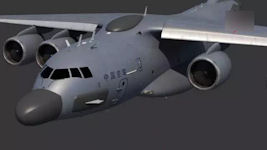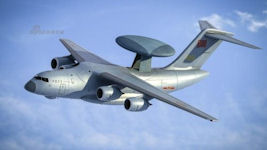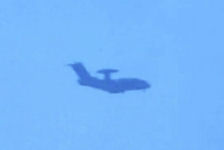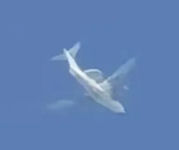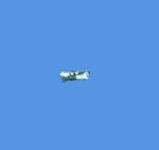Yun 20 KJ-3000 AEW
China can no longer "hide its strength and bide its time". The war of public opinion has been going on. China's first sixth-generation fighters, China's first fourth-generation early warning aircraft, China's largest amphibious assault ship... The pace is too fast! Two types of sixth-generation aircraft appeared in the world at the same time one in the south and one in the north (Chengfei and Shenfei tested on the same day). The first Type 076 amphibious assault ship "51 Sichuan" independently developed by China was officially launched. There is news that the new generation of early warning and control aircraft KJ-3000 also made its maiden flight on 27 December 2024. If the People's Army after it has developed continues to procrastinate on solving the Taiwan issue, then it is obvious that the unrest within the society will not be so easy to control. Which side is more important?
Chengdu Aircraft Corporation came before Shenyang Aircraft Corporation, and Shenyang Aircraft Corporation came before Xi'an Aircraft Corporation. According to online news, the KJ-3000 early warning aircraft developed by Xi'an Aircraft Corporation based on the Y-20B made its first flight! Moreover, this is based on the Y-20B, and the modified aircraft uses a larger bypass ratio engine - the WS-20. For the early warning aircraft, this meant that it can maintain a longer airborne time and maximize its own long-range air warning capability.
The photos released publicly on the Internet appeared very blurry, but netizens with military knowledge can identify that it is the KJ-3000 early warning aircraft that was previously rumored to be being built by Xi'an Aircraft Industry Company of AVIC Group. Previously, there were rumors that the KJ-3000 would remove the large disc and use a conformal antenna. But the photos that have been circulated now show that it still uses the traditional large disc antenna, but the power should be greater than that of the previous generation KJ-2000.
In addition, some people mentioned that the KJ-3000 will use smart skin technology. What is smart skin technology? It is a material with self-repairing function, which enables this early warning aircraft to achieve automatic repair material application when it is impacted or damaged by the outside world. This cannot be judged from the pictures circulated on the Internet. We can only know after the official announcement.The Y-20B is based on the Y-20A transport aircraft, and is equipped with the domestically produced WS-20 high-bypass turbofan engine, commonly known as the "big barrel". It was once believed that it would take until the end of 2024 at the earliest to trial-produce one or two for verification flights. What most people did not expect was that it was reported that in March 2023, it was discovered that the Y-20B had officially entered service. In March 2024 of this year, foreign media reported that Xi'an Aircraft Corporation had delivered four Y-20Bs at one time, which was even more surprising. This shows that this engine has completed various comprehensive performance tests, indicating that my country's WS-20 engine has been fully mature and has reached the standard for installation and service. At the same time, the production of so many aircraft in a short period of time also shows that the production capacity of the Y-20B pulsation production line is very strong. In short, it means that my country's production and technology in the aviation field have reached a very high level.
The pulse line is a kind of assembly line production method. Compared with the traditional assembly line, it is more efficient and flexible. It can quickly respond to market demand and improve production efficiency by optimizing production processes and resource allocation. In the current supply chain terminology, it is "flexible production". The design concept of this production line is based on imitating the pulse mode of blood flow when the human heart beats, that is, a certain number of products are concentratedly produced within a certain period interval, and then a short rest period is entered, and then production starts again, and so on.
The pulse production line developed by Xi'an Aircraft Corporation is particularly suitable for production requirements that require a high degree of customization and flexibility, such as the assembly of aircraft parts and preparations before test flights. This method can improve the efficiency of aircraft production lines, reduce resource waste, and speed up product delivery, thereby better meeting customer needs and product changes brought about by upgrades and iterations.
The Y-20B has impressive dimensions: 47 meters long, 45 meters wingspan, 15 meters high, a service ceiling of 13,000 meters, a maximum load capacity of 66 tons, and a maximum take-off weight of 220 tons. Thanks to its huge fuselage, it can carry a variety of airborne electronic equipment, making the KJ-3000 also have a strong electronic countermeasure capability. It can not only interfere with the enemy's radar and communication systems, but also effectively reduce the stealth effect of the enemy's stealth fighter. At the same time, it can also enhance our ability to detect and strike stealth targets. Therefore, this early warning aircraft is not just a single flying platform, it is more like an "information center" in the air. In addition to the radar system, the KJ-3000 is also equipped with a variety of advanced instruments such as infrared sensors and electronic reconnaissance equipment. These sensors can work together to provide commanders with rich and accurate battlefield information.
Today's headlines may be talking about two new 6th generation combat/air combat platforms, but the appearance of KJ-3000 should never be underestimated. It is a killer weapon for China. Because it will significantly enhance combat capability, forming "one-way transparency" on the battlefield, and better form the effect of "finding the enemy first". With "air detectives" like KJ-3000, stealth fighter-bombers equipped with ultra-long-range air-to-air and ground-to-ground missiles can fire first at the enemy. In general, the KJ-3000 is an advanced early warning aircraft that integrates multiple functions such as early warning, command, and intelligence collection.
The early warning aircraft is known as the "Eye of the Air Force" and has an extremely important role in modern warfare. It is reported that China is very likely to develop a new type of air police-3000 early warning aircraft based on the Y-20 large transport aircraft. This land-based early warning aircraft will become "the largest and most powerful early warning aircraft of the Chinese Air Force."
China s currently equipped Air Police 2000 early warning aircraft is based on the Il 76 transport aircraft and has been discontinued due to supply reasons. It is undoubtedly good news to develop a new generation of large early warning aircraft with Yun 20. According to the CG graphic, China Yun 20 has been replaced with a domestic engine, and mass production has begun, and more than five had been produced since the end of 2018. After the domestic engine is replaced, the Yun-20 can further expand its output, and is fully capable of supplying special military aircraft for modification while meeting the Air Force's strategic transportation.
In January 2018 a Russian media published an article saying that China is developing the domestically-produced KJ-3000 early warning aircraft based on the Y-20. Since China has made significant progress in early warning aircraft, the KJ-3000 may no longer adopt a conventional layout in terms of technology, but a more advanced conformal airborne early warning platform. If successfully developed, the KJ-3000 will undoubtedly be a very sci-fi large early warning aircraft.
The KJ-3000 is the third-generation airborne early warning aircraft developed by the Chinese Air Force. Compared with traditional early warning aircraft, the KJ-3000 cancelled the large roto-dome ["pot cover"] on the back of the aircraft that is common to everyone. This also means that China has completely won the competition for the new generation of early warning aircraft. In particular, the KJ-3000, its fuselage ws already the Y-20 heavy transport aircraft that China was mass-producing.
The modified KJ-3000 planned to use the world's most advanced skin-type active electronic phased array radar. Therefore, the weight of the KJ-3000 early warning aircraft will be reduced, and the fuel capacity in the aircraft will also be increased. Therefore, the maximum range of the KJ-3000 can reach about 7,500 kilometers, or the maximum hovering time is about 9 hours. Such a long hovering time allows the KJ-3000 to perform missions with the least sorties. Usually only three KJ-3000s are needed to monitor up to nearly 50,000 square meters of air area 24 hours a day. In addition, the KJ-3000 has planned to install aerial refueling equipment, so that it can carry out 24-hour uninterrupted combat missions if necessary.
In terms of radar, the KJ-3000 is currently planned to be equipped with the most advanced skin-type active phased array radar, which has many advantages such as light weight, long fault interval, easy installation, strong anti-interference ability, and low cost. The KJ-3000 plans to install this skin-type active phased array radar on the back, belly, bottom, both sides of the fuselage, and the nose. According to similar international products, we can infer that the radar equipped with the KJ-3000 has a maximum detection range of about 600 kilometers and can track at least 100 air targets at the same time.
When the KJ-3000 is cruising at an altitude of 8,500 meters, the radar will have a detection range of more than 600 kilometers for large high-altitude targets such as the B52, and a detection range of about 500 kilometers for medium-sized targets such as the Tu-16; it also has a detection range of 350 kilometers for larger targets such as the F15 at low altitudes. Through advanced data links and supercomputers, the KJ-3000 can display the complete land, sea, and air situations to the commander on a large color LCD screen. In short, the new generation of KJ-3000 early warning aircraft developed on the basis of the Y-20 will have a huge improvement in its comprehensive combat performance.
It was reported that the KJ-3000 AWACS has the ability to combine ground reconnaissance and air surveillance. The U.S. military combines the E-8 and E-3 to form the E-10 "multi-sensor command and control" aircraft. However, after more than 10 years of development, the E10 aircraft has not yet been officially equipped. It can be seen that there are still certain difficulties in realizing this technology. If China's KJ-3000 combines ground reconnaissance and air surveillance, it is likely to become the world's first AWACS aircraft to achieve this function. In this way, it will be something that the Chinese people will be proud of.
According to a report published in Hong Kong's "Ta Kung Pao" on 18 February 2019, the China Air Police-3000 land-based early warning aircraft will have anti-stealth performance, improve detection capabilities for stealth fighters, cruise missiles and other targets, and become an air command coordination center.
It is reported that with the continuous development of electronic technology, the early warning aircraft has gradually become an air command and guidance center, and has become an air force combat multiplier under the conditions of informationization. It is indispensable in both offensive and defensive aspects: on the one hand, it is to defend against enemy cruise missiles and fighter aircraft attacks. "Sentinel", on the other hand, can guide their fighters and ships to implement combat strikes, improving attack accuracy and efficiency. According to Russian "Foreign Military Review" previously reported, China is developing the Air Police-3000 land-based early warning aircraft and Air Police-600 shipborne early warning aircraft, drawing on the design schemes of the US E-3 and E-2D early warning aircraft, respectively.
Among them, Air Police- 3000 may use the Y-20 heavy military transport aircraft as a modified platform. It will become China's largest early-warning aircraft model in the future, and will surpass the three active early-warning aircrafts in terms of detection performance, range, and information level.
According to reports, Airborne-3000 will use an active phased array radar's long-range radar alerting and control system, which can perform circumferential scanning with a maximum detection distance of not less than 500 kilometers. A series of tactical and technical performance of airborne electronic equipment will be further improved. Analysis points out that Air Police- 3000 can find aircraft using stealth technology, including the US F-22 and F-35 multipurpose fighters. In appearance, Air Police-3000 may abandon the "big disc" radar fairing and change to multiple common radars.
Hong Kong media said that the China-made large-scale strategic transport aircraft Y-20 was officially commissioned in July 2016. Because of its open architecture, the aircraft has a strong potential for retrofitting and can be equipped with special support aircraft such as early warning aircraft and tankers. platform. Therefore, some analysts believe that the Yun-20 will replace the Il-76 as the platform of choice for a new generation of large-scale early warning aircraft.
The article points out that the development of Air Police-3000 and Air Police-600 will enrich China s early-warning aircraft family, so that China s airpower will obtain more air-warning platforms with long detection distances, strong low-altitude detection capabilities, and large mobile ranges, forming a large-scale The full lineage of early warning aircraft complemented by early warning aircraft, medium-sized early warning aircraft, early warning helicopters, and unmanned early warning aircraft.
The outside world generally regards the Air Police-1 developed in the 1960s as China's first generation of early warning aircraft. The Air Police -200 and Air Police -2000 in the 21st century are the second generation, while the Air Police -500 is the third generation. At present, Air Police-200, Air Police-2000, and Air Police-500 constitute the main lineup of the PLA's active duty early warning aircraft, especially the latter two as the main force.
By comparison, the Air Police-2000 developed on the basis of the Russian-made Il-76 is the largest, and the Air Police-500 is based on a Chinese-made Yun-9 as a modified platform. Although it is relatively small, it uses a more advanced digital array radar. , And achieved national production.
In 2017, the deployment of the Air Police-500 in Hainan, coupled with the ground radar stations in some islands and reefs in the South China Sea, has basically established a complete air condition detection and alert network in the South China Sea airspace, strengthening China's control over the situation in the South China Sea. In addition, China also developed and delivered the ZDK-03 medium-sized early warning aircraft for the Pakistan Air Force.
China may no longer need radars with early warning aircraft on the back of the aircraft, but instead needs Gulfstream similar to Singapore Air Force equipment. G550 early warning aircraft, this conformal airborne early warning platform, is the standard for the new generation of large-scale early warning aircraft of the Chinese Air Force.
Academician Wang Xiaomo, the father of China's early warning aircraft, also said that China's next generation of early warning aircraft will use conformal antennas. It is reported that with the development of electronic technology, the trend of integration of early warning aircraft is becoming more and more obvious. The first is reflected in the integration of the fuselage and the antenna. The conformal antenna is used to make the antenna conform to the shape of the fuselage surface, which can minimize the impact on the aerodynamic performance of the aircraft after installing the antenna, and at the same time, it can more fully use the space on the fuselage surface to increase the antenna area.
The Air Police 3000 developed on the basis of the Yun 20 transport aircraft uses S-band radars at the nose and nose, and L-band radars at both sides of the fuselage to provide comprehensive coverage, increase electronic support and adjustment equipment, and increase satellite communications and line-of-sight. Link and other equipment, under this design, the Air Police 3000 is different from other early warning aircraft already in service in China, and its comprehensive technology has been upgraded by more than one generation.
Some media believe that China's next-generation early warning aircraft is likely to be developed at the same time as the Yun-20 transport model, which has realized radio frequency integration. At present, the development of broadband technology in China breaks through the limitation of the performance of traditional antennas that are limited by the operating wavelength, so that the same antenna can work in a very wide wavelength range. Electronic systems that need to work in different bands such as radar, communication or reconnaissance can Works through an antenna.
Finally, the processing system of Air Police 3000 was integrated. There are servers, workstations, and computers that serve various systems (such as radar, communications, and reconnaissance) on the early warning aircraft. With the advancement of computer technology, in the future, on the early-warning machine, the powerful integrated core processor can integrate the functions of the previous mission computer, weapon control computer, signal processor and other computers that control their respective devices.
It is reported that another important idea for the integration of the Air Police-3000 early warning aircraft is to combine ground reconnaissance and air warning. The US military's approach is to combine E-8 and E-3 to form E-10 "multi-sensor command and control" Airplane, but failed to equip it after more than 10 years. It is no longer technically difficult to realize this kind of thinking. China Air Police-3000 will likely become the world's first early-warning machine to implement this function. In this way, it will be a complete excitement for Chinese military fans.
But conformal antennas are not only more difficult to design, but also very expensive. In addition, conformal antennas have poor forward and backward field of view detection performance, which weakens the ability to continuously grasp the air situation in the war zone. It is precisely because of these considerations that the PLA Air Force decided to continue to use traditional antenna layout for KJ-3000, leaving conformal antennas for unmanned long-endurance early warning aircraft.
In 2023 a Western commercial satellite acquired an image of what is said to be a phased array radar ground test bench in China. Three disc-shaped radar antennas of different sizes and shapes can be clearly seen. By comparing the antenna design features and size, it can be determined that one was the fixed three-sided active phased array radar of the KJ-500, and another one on the far right is the mechanically rotating two-sided passive phased array radar specially used for the ZDK-03 early warning system of Pakistan.
The radar antenna in the middle was unfamiliar. It seemed to be similar to the two-sided array of ZDK-03, but the size is much larger. Obviously, this is not the fixed three-sided active phased array radar of KJ-2000, so its identity is likely to be the radar of KJ-3000 we mentioned earlier. From the picture, the KJ-3000 early warning aircraft has returned to the traditional circular antenna cover diameter layout antenna, and did not use the three-sided array antenna of KJ-2000 or the more advanced conformal antenna design.
The reason why the KJ-3000 radar arranged its radar antenna in this way is to maximize the antenna aperture, thereby improving the radar detection distance and performance, so as to counter the fifth-generation aircraft and the sixth-generation full-stealth fighter that will appear after 2030. According to the radar detection range formula, antenna aperture and radiation power determine the two key parameters of radar detection performance. To improve radar detection range and performance, we must first make breakthroughs in these two parameters. The PLA's existing KJ-2000 and KJ-500 both use fixed three-sided array radars. The advantage of this design is that it can simultaneously achieve electronic scanning in all directions. The radar can quickly intercept, confirm, track and lock targets, and is suitable for dealing with saturation attacks and highly maneuverable targets. However, the three-sided array antenna design is bound to make concessions in aperture size, which limits the detection distance and performance of the radar to a certain extent.
In order to ensure that the early warning aircraft has sufficient detection performance, increasing the antenna aperture is a very safe approach. With this in mind, the KJ-3000 abandoned the already mature three-sided array antenna arrangement of the KJ-2000 and KJ-500, and returned to the traditional two-sided array design arranged according to diameter, in order to better counter foreign sixth-generation stealth fighters.
The diameter of the AWACS radar antenna fairing is at most one-third of the fuselage length, and the thickness is another one-third of the diameter. The length of the Y-20 is about 53 meters, so the diameter of the KJ-3000 radar antenna fairing is at most 17 meters, and the thickness is about 5 meters. Such a large antenna fairing can be installed with an antenna with a large enough aperture to ensure the detection performance of the antenna.
Of course, only one or two antenna arrays can be arranged in this way. The disadvantage of the planar phased array antenna is that the scanning range is small. When the scanning angle increases, the beam will be widened, the effective aperture projection area will be reduced, and the radar detection performance will be reduced. Therefore, the scanning angle of a planar phased array antenna is about 120 degrees, which cannot achieve omnidirectional coverage. Even if another one is added on the back, it is only 240 degrees. In order to achieve omnidirectional coverage, only a mechanical scanning mechanism can be added, but it is very difficult to rotate such a large antenna cover. The size and weight of the mechanical rotating mechanism will be very large, which puts higher requirements on the carrier aircraft.
The Y-20 large transport aircraft has a large internal space, which can accommodate more display consoles and communication equipment. Air combat between fighters requires early warning aircraft to provide detailed command and guidance, which requires the aircraft to have a large internal space to accommodate more equipment. Judging from the internal space of the Y-20 large transport aircraft, it can accommodate more than 10 display consoles and provide command and guidance for more than 20 fighters.
The operation of these onboard integrated systems may support network-based operations , enabling the KJ-3000 early warning aircraft to act as an airborne command center in the sky and coordinate operations of multiple platforms in complex combat environments. In addition to guiding fighter jets and other air platforms, the KJ-3000 early warning aircraft can even cross services when necessary to directly command the navy's surface ship formations to perform air defense and anti-missile and sea and land strike missions .
Once the KJ-3000 large early warning aircraft is put into service, it will provide the Chinese People's Liberation Army with a strategic advantage in extremely complex combat scenarios such as strong electronic interference in the future, relying on its extraordinary ability to detect airspace, and it will compete with the J-20, J-35 stealth fighterThe close cooperation and coordination between the Chinese and even sixth-generation fighter jets will significantly increase the combat range of the Chinese military and expand its surveillance and control capabilities.
|
NEWSLETTER
|
| Join the GlobalSecurity.org mailing list |
|
|
|


